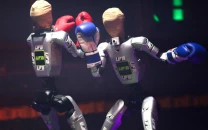Webb Telescope uncovers six rogue worlds, providing new clues on how stars are born
The findings come from survey of the young nebula NGC1333, a star-forming cluster about a thousand light-years away

The James Webb Space Telescope has identified six potential rogue worlds—planetlike objects untethered from any star’s gravity. Among them is the lightest object ever found with a dusty disk around it.
These elusive objects provide new evidence that the same cosmic processes that create stars may also be responsible for forming objects only slightly larger than Jupiter.
“We are probing the very limits of the star-forming process,” said lead author Adam Langeveld, an astrophysicist at Johns Hopkins University. “If you have an object that looks like a young Jupiter, is it possible that it could have become a star under the right conditions? This is important context for understanding both star and planet formation.”
The findings come from Webb’s deepest survey of the young nebula NGC1333, a star-forming cluster about a thousand light-years away in the Perseus constellation. A new image released by the European Space Agency shows NGC1333 glowing with dramatic interstellar dust and clouds. The survey’s results have been accepted for publication in *The Astronomical Journal*.
Webb’s data suggest these discovered worlds are gas giants, five to ten times more massive than Jupiter. This makes them some of the lowest-mass objects ever found that likely formed through processes typically associated with star and brown dwarf creation—celestial bodies that straddle the boundary between stars and planets but never ignite hydrogen fusion.
“We used Webb’s unprecedented sensitivity at infrared wavelengths to search for the faintest members of a young star cluster,” said Johns Hopkins Provost Ray Jayawardhana, an astrophysicist and senior author of the study. “It turns out the smallest free-floating objects that form like stars overlap in mass with giant exoplanets circling nearby stars.”
Despite Webb’s sensitivity, the observations revealed no objects lighter than five Jupiter masses. This suggests that any lighter stellar objects likely form the way planets do, the authors concluded.
“Our observations confirm that nature produces planetary mass objects in at least two different ways—from the contraction of a cloud of gas and dust, as stars form, and in disks of gas and dust around young stars, as Jupiter in our own solar system did,” Jayawardhana added.
The most intriguing of these starless objects is also the lightest, with an estimated mass of five Jupiters (about 1,600 Earths). The presence of a dusty disk suggests it almost certainly formed like a star, as space dust typically spins around a central object during the early stages of star formation, according to Langeveld, a postdoctoral researcher in Jayawardhana’s group.
Disks are also essential for the formation of planets, implying that these observations could have significant implications for the potential formation of “mini” planets.
“Those tiny objects with masses comparable to giant planets may themselves be able to form their own planets,” said co-author Aleks Scholz, an astrophysicist at the University of St Andrews. “This might be a nursery of a miniature planetary system, on a scale much smaller than our solar system.”
Using the NIRISS instrument on Webb, the astronomers measured the infrared light profile of every object in the star cluster and reanalyzed 19 known brown dwarfs. They also discovered a new brown dwarf with a planetary-mass companion, a rare finding that challenges current theories of how binary systems form.
“It’s likely that such a pair formed the way binary star systems do, from a cloud fragmenting as it contracted,” Jayawardhana explained. “The diversity of systems that nature has produced is remarkable and pushes us to refine our models of star and planet formation.”
Rogue worlds may originate from collapsing molecular clouds that lack the mass for nuclear fusion, which powers stars. They might also form when gas and dust in disks around stars coalesce into planetlike orbs that are later ejected from their star systems, likely due to gravitational interactions with other bodies.
These free-floating objects blur the lines between celestial classifications, as their masses overlap with gas giants and brown dwarfs. Although such objects are considered rare in the Milky Way galaxy, the new Webb data show they account for about 10% of celestial bodies in the targeted star cluster.
In the coming months, the team will study more of these faint objects’ atmospheres and compare them to heavier brown dwarfs and gas giant planets. They have also been granted additional time on the Webb telescope to explore similar objects with dusty disks, investigating the possibility of forming mini planetary systems akin to Jupiter’s and Saturn’s numerous moons.
The news appeared on Eureka Alert website.



















COMMENTS
Comments are moderated and generally will be posted if they are on-topic and not abusive.
For more information, please see our Comments FAQ